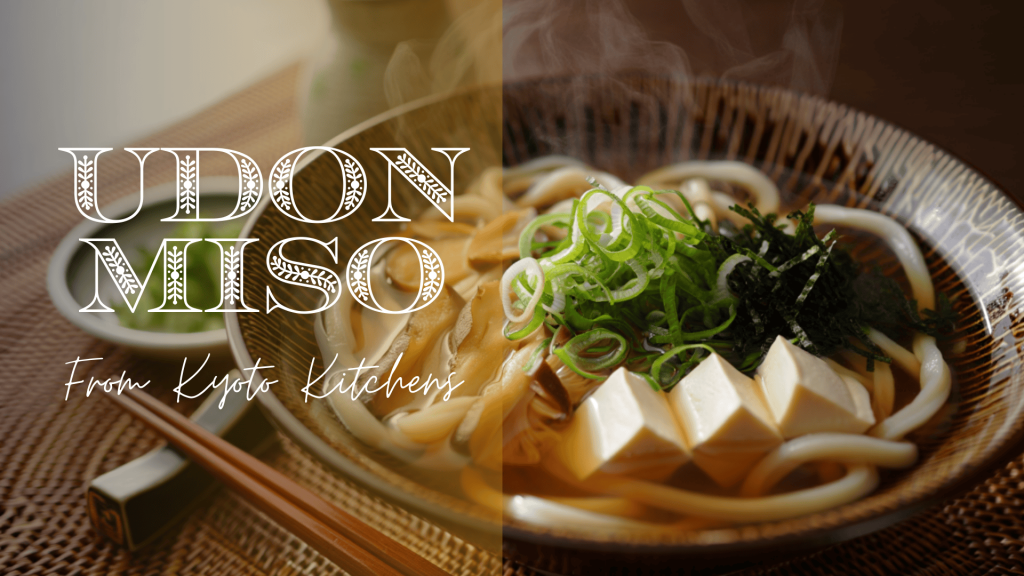The warm comfort of a steaming bowl of udon miso soup offers comfort few dishes can match.
This Japanese classic combines two culinary powerhouses—thick, chewy udon noodles and umami-rich miso broth—creating a meal that satisfies both body and soul.
Home cooks worldwide have fallen for this adaptable dish that works as a quick lunch, hearty dinner, or restorative meal during cold seasons. Udon miso soup stands out in the vast landscape of noodle soups for its remarkable simplicity and depth of flavor.
Beyond its irresistible taste, this bowl packs impressive nutritional benefits from fermented miso to energy-boosting noodles.
Ready to find the secrets behind a perfect bowl? Let’s see the intriguing origins, essential ingredients, and foolproof techniques that make udon miso soup a beloved staple in kitchens across the globe.
What is Udon Miso Soup?
Udon miso soup brings together two beloved Japanese staples in one soothing bowl. Udon noodles are thick, chewy wheat noodles with a satisfying texture that stands up beautifully in hot broth.
Miso soup is a traditional Japanese soup made from miso paste, which comes from fermented soybeans, giving it a deeply savory, umami-rich flavor.
When combined, these elements create a hearty, comforting dish that’s both nourishing and satisfying.
The thick, slippery noodles absorb the complex flavors of the miso broth while adding substantial texture. Popular variations include adding tofu, green onions, mushrooms, or seafood.
Some people prefer a lighter broth with just a few toppings, while others load their bowls with vegetables and proteins.
This versatile dish is a favorite in Japanese home cooking because it’s easy to prepare, warms you from the inside out, and can be customized to use whatever ingredients you have on hand.
Origin of Udon Miso Soup

Udon noodles have deep roots in Japanese cuisine, dating back to around the 8th century when wheat cultivation techniques were introduced from China.
These thick, wheat-based noodles became a staple in many regions of Japan, particularly in the western areas.
Miso soup, meanwhile, has been fundamental to Japanese dining for over a thousand years, with miso paste first appearing in the Heian period (794-1185).
The fermented soybean paste was prized for its preservability and rich flavor. The combination of udon and miso likely emerged naturally in home kitchens as families looked for hearty, satisfying meals using everyday ingredients.
This practical pairing gained popularity because it brought together the filling quality of udon with the nutritional benefits and deep flavor of miso.
Over time, the dish developed differently across Japan’s regions, with northern areas often preferring heartier versions with more vegetables and proteins, while southern regions might serve lighter variations, reflecting local tastes and available ingredients.
Key Ingredients
Udon miso soup relies on a few essential components that create its distinctive flavor and texture. The quality of your ingredients will greatly impact the final dish, so choose the best you can find.
While traditional recipes follow certain guidelines, feel free to adapt based on your preferences and what’s available to you.
- Udon Noodles: Available fresh, frozen, or dried.
- Miso Paste: Choose white (mild), red (stronger), or mixed varieties.
- Dashi Stock: Made from kombu seaweed, bonito flakes, or anchovy base.
- Vegetables: Green onions, mushrooms, bok choy, carrots, spinach.
- Proteins: Soft tofu, crispy tempura, poached egg, sliced chicken, or beef.
- Flavor Enhancers: Soy sauce, mirin (sweet rice wine), sesame oil.
The beauty of udon miso soup lies in its versatility. You don’t need all these ingredients for a delicious bowl – even just good noodles, miso, and dashi make a satisfying meal.
Pro Tip: Remember not to boil miso directly to preserve its probiotics and flavors.
How to Make Udon Miso Soup in 5 Easy Steps
Making udon miso soup at home is simpler than you might think. Once you have all your ingredients ready, this warming dish comes together quickly. Follow these five steps for a delicious bowl that rivals your favorite Japanese restaurant.
Step 1: Prepare the Dashi Broth
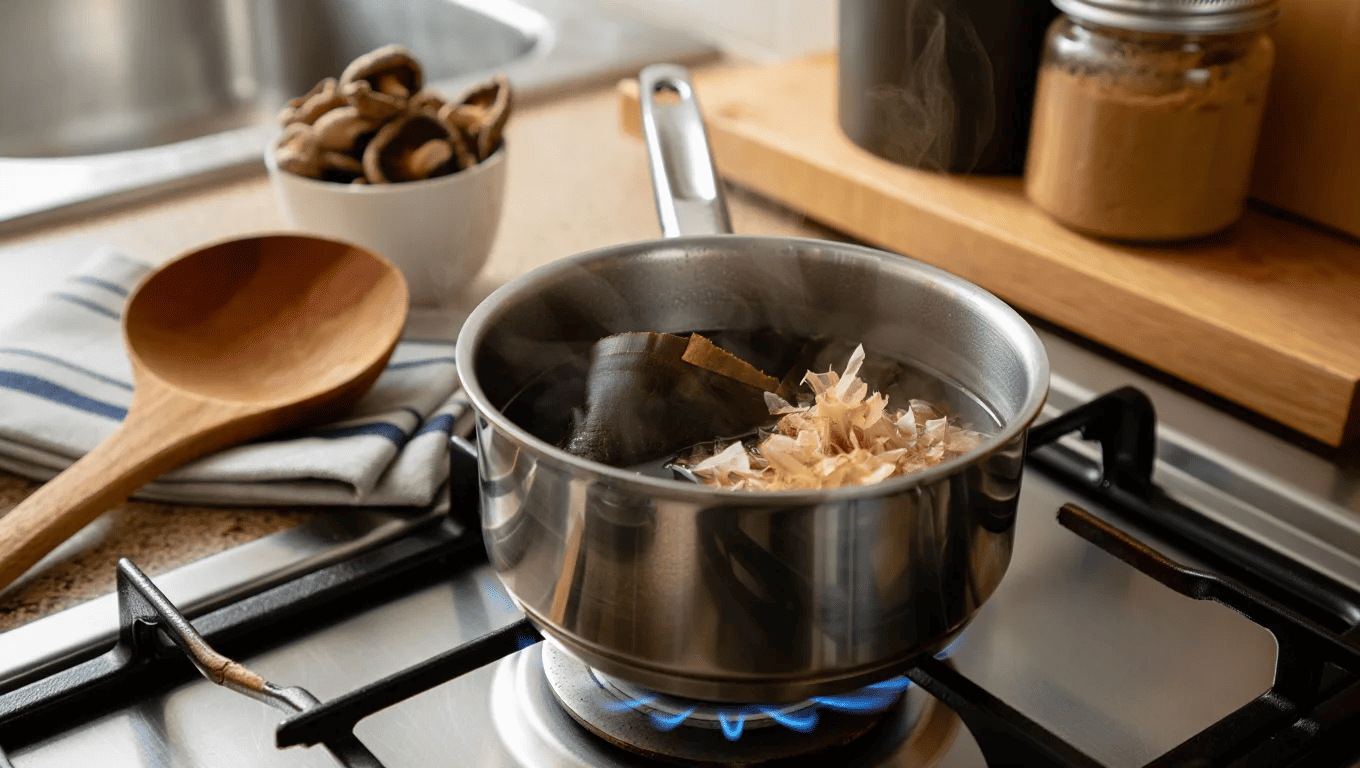
Start by creating the flavorful base for your soup. In a pot, bring 2–3 cups of water to a boil, then add a piece of kombu (dried kelp) and a handful of bonito flakes.
These traditional Japanese ingredients infuse the water with umami flavors. Let everything simmer gently for 5–10 minutes to extract the rich taste. If you’re short on time, instant dashi powder works well too—just follow the package instructions.
For a vegetarian version, you can use only kombu or make a broth with dried shiitake mushrooms instead. Once the broth is fragrant, strain out the solids to get a clear dashi.
Step 2: Cook the Udon Noodles
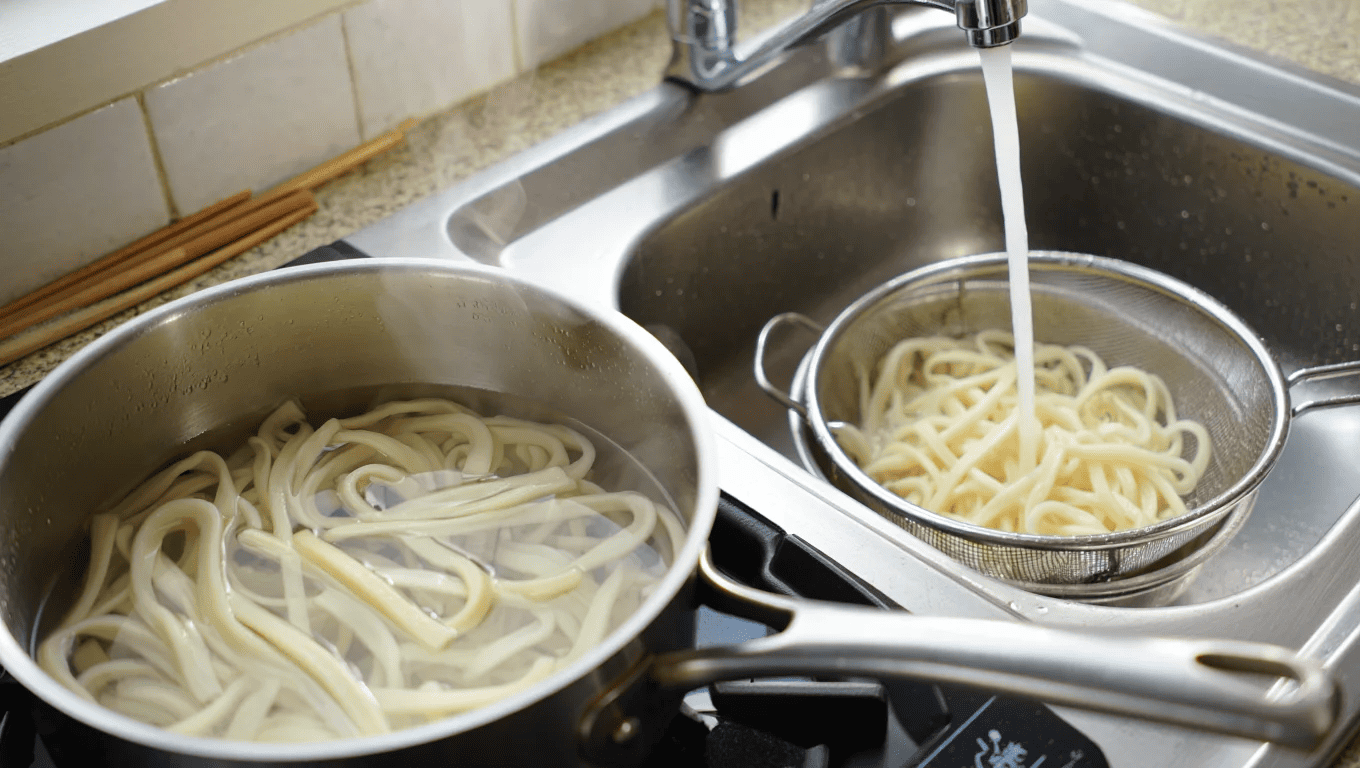
While your broth is simmering, prepare your udon noodles according to the package directions. Fresh udon typically needs just 2–3 minutes in boiling water, while dried varieties might require longer cooking times.
Be careful not to overcook them—they should remain chewy with some bite. When they reach the perfect texture, drain them in a colander and give them a quick rinse under cold water.
This stops the cooking process and removes excess starch, preventing them from getting sticky. Keep the noodles separate from your broth until the final assembly to ensure they don’t become soggy by absorbing too much liquid.
Step 3: Add Vegetables and Protein
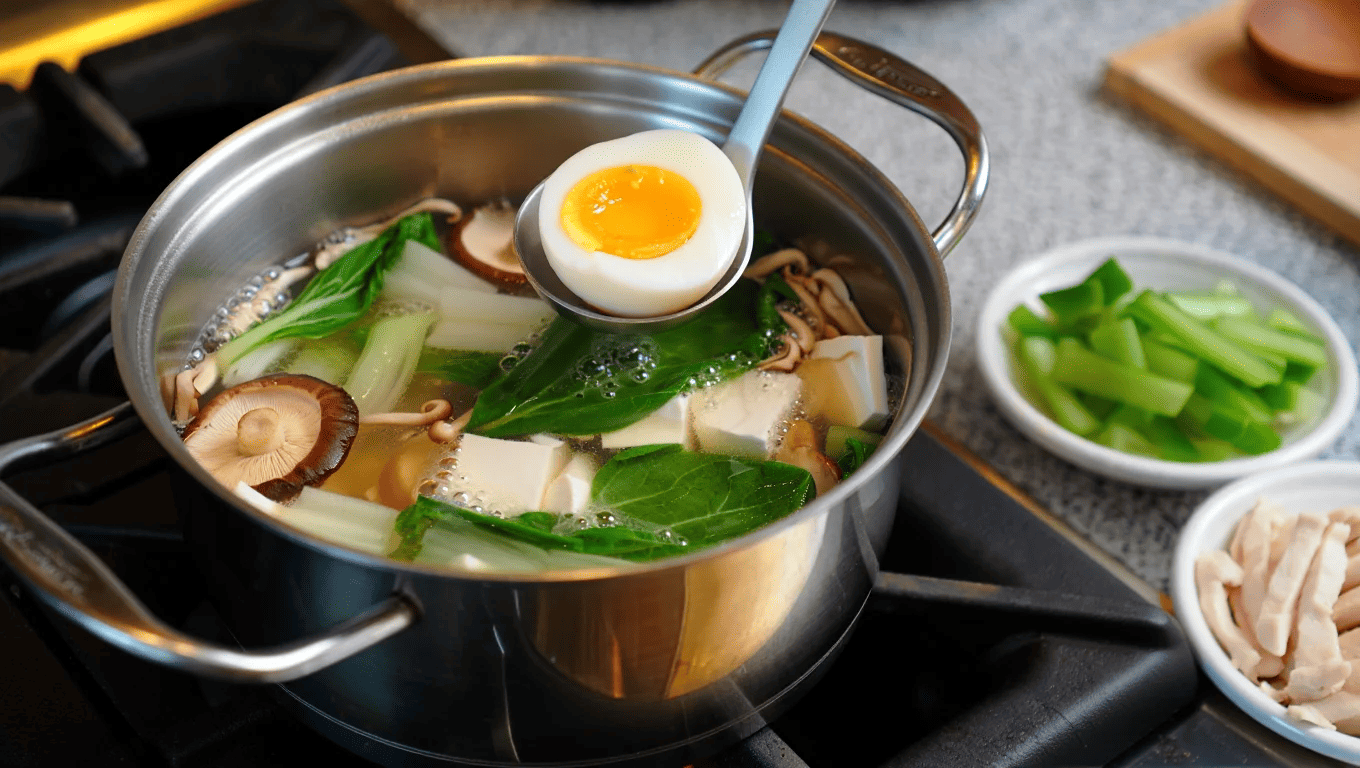
Return your strained dashi broth to a gentle simmer, and now it’s time to add color and nutrition. Add your choice of vegetables, such as sliced mushrooms, baby bok choy, or handfuls of spinach—these cook quickly and add different textures to your soup.
For protein, soft tofu cubes work wonderfully as they absorb the soup’s flavors. A soft-boiled egg adds richness, or use leftover cooked chicken or beef for a heartier version.
Let everything simmer gently for 3–5 minutes, just until the vegetables are tender but still have some crispness. The brief cooking preserves the vegetables’ nutrients and bright colors, making your soup both healthy and visually appealing.
Step 4: Mix in the Miso Paste
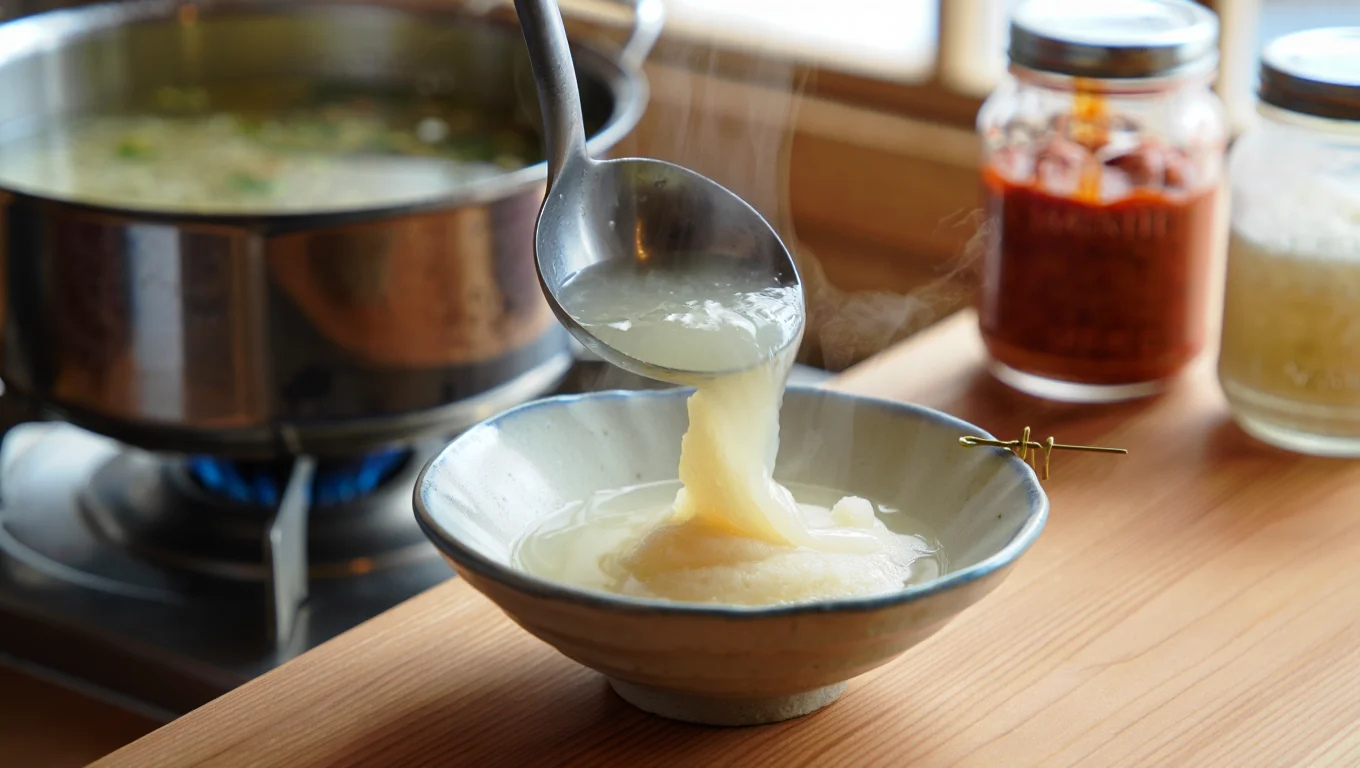
This step requires attention—miso’s beneficial probiotics and complex flavors are destroyed by high heat. Turn your heat to low so the broth isn’t boiling.
Take a ladleful of the hot broth and put it in a small bowl with 1–2 tablespoons of miso paste. Use a small whisk or fork to dissolve the paste completely, breaking up any clumps. Once smooth, pour this mixture back into the pot and gently stir to distribute the miso throughout the broth.
Taste your soup and add more dissolved miso if you want a stronger flavor. White miso gives a milder, sweeter taste, while red miso provides a deeper, more robust flavor.
Step 5: Assemble and Serve

The final step brings everything together into a beautiful, steaming bowl of comfort. Place your cooked udon noodles into individual serving bowls—they form the foundation of your dish.
Ladle the hot miso broth with all the vegetables and protein over the noodles. The heat will warm the noodles back up perfectly. Finish with fresh toppings like thinly sliced green onions for brightness and color.
A light drizzle of toasted sesame oil adds a wonderful aroma, while a dash of soy sauce can deepen the flavor if needed. For those who enjoy some heat, sprinkle on some chili flakes or Japanese seven-spice blend (shichimi togarashi). Serve immediately while hot for the best experience.
Health Benefits of Udon Miso Soup
Udon miso soup isn’t just delicious – it’s nutritious too. Fermented miso provides gut-supporting probiotics, while the combination of noodles, vegetables, and protein creates a balanced meal that satisfies hunger.
- Miso provides beneficial probiotics that support gut health, immune function, and may help reduce inflammation.
- The combination of udon noodles and broth offers sustaining energy and hydration, making it especially beneficial on cold days.
- Adding vegetables enhances the meal with essential fiber, vitamins, and minerals for improved nutrition.
- Protein additions like tofu or egg increase satiety and create a more complete, balanced meal.
- The dish is naturally low in fat when prepared traditionally, yet remains highly customizable to accommodate various dietary needs and preferences.
Enjoying this soup regularly can be part of a healthy diet. The mix of complex carbs, protein, and vegetables keeps you full without feeling heavy.
Homemade versions let you control sodium and customize ingredients to meet your nutritional needs.
Perfect Pairings with Udon Miso Soup
Udon miso soup is delicious on its own, but pairing it with complementary foods and drinks creates a more satisfying meal. Traditional Japanese dining emphasizes balance in flavors, textures, and temperatures. These pairings enhance your soup experience without overwhelming the flavors.
| CATEGORY | OPTIONS | WHY IT WORKS |
|---|---|---|
| Side Dishes | Tempura | Crispy Contrast to Soft Noodles |
| Onigiri | Rice Balls for Added Filling | |
| Japanese Pickles | Tangy Palate Cleanser | |
| Drinks | Green Tea | Classic, Aids Digestion |
| Sake | Complements Umami Flavors | |
| Barley Tea | Refreshing Cold Option | |
| Desserts | Mochi Ice Cream | Sweet, Cool Finish |
| Fresh Fruit | Light, Cleansing End | |
| Green Tea Ice Cream | Continues the Tea Theme |
Feel free to mix and match these pairings based on what you enjoy most. You don’t need everything on this list for a great meal. Even adding just one side dish and a suitable drink will create a more complete dining experience.
Wrapping It Up
Udon miso soup represents Japanese cuisine at its finest—straightforward yet deep, humble yet nourishing. The magic lies in quality ingredients and mindful preparation, honoring each component from the dashi base to the final garnish.
As you master this dish, you’ll find endless variations to suit your taste, mood, and available ingredients.
The beauty of udon miso soup extends beyond flavor—it offers a moment of mindfulness as you savor each spoonful of broth and each slurp of noodles.
This centuries-old recipe connects you to culinary traditions while adapting perfectly to modern life. Next time you crave comfort food with substance, skip the processed options and reach for your pot.
A bowl of homemade udon miso soup awaits, bringing warmth, health benefits, and culinary joy to your table in just minutes.
Return soon for fresh food tips, campfire recipes, and creative outdoor cooking ideas.

